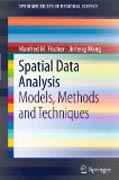
Spatial data analysis: models, methods and techniques
Fischer, Manfred M.
Wang, Jinfeng
The availability of spatial databases and widespread use of geographic information systems has stimulated increasing interest in the analysis and modellingof spatial data. Spatial data analysis focuses on detecting patterns, and on exploring and modelling relationships between them in order to understand the processes responsible for their emergence. In this way, the role of space is emphasised , and our understanding of the working and representation of space, spatial patterns, and processes is enhanced. In applied research, the recognition of the spatial dimension often yields different and more meaningful results and helps to avoid erroneous conclusions. This book aims to provide an introduction into spatial data analysis to graduates interested in applied statistical research. The text has been structured from a data-driven rather than a theory-based perspective, and focuses on those models, methods and techniques which are both accessible and of practical use for graduate students. Exploratory techniques as well as more formal model-based approaches are presented, and both area data and origin-destination flow data are considered. The book helps the reader. To learn quickly the best practice models, methods and techniques in spatial data analysis. To learn how to correctly interpret the results of spatial regression models, an issue that had been largely neglected in the past. To learn to relax the independence assumption in spatial interaction modelling to account for the spatial dependence in origin-destination flows. INDICE: Preface. Part A: The Analysis of Geostatical Data. Part B: The Analysis of Area Data. Part C: The Analysis of Spatial Interaction Data. Subject Index. Author Index.
- ISBN: 978-3-642-21719-7
- Editorial: Springer Berlin Heidelberg
- Encuadernacion: Rústica
- Páginas: 80
- Fecha Publicación: 31/08/2011
- Nº Volúmenes: 1
- Idioma: Inglés
